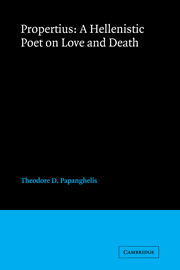Book contents
- Frontmatter
- Contents
- Preface
- Abbreviations
- 1 Introductory
- 2 nostris puer haesit ocellis: the lessons of 1.19
- 3 in amore mori: witches and lovers
- 4 in amore mori: the funeral
- 5 in amore mori: the shipwreck
- 6 in amore mori: crime passionnel
- 7 in amore mori: minor instances in Book 2
- 8 Strange beauty: a reading of 4.7
- 9 Concluding thoughts
- Bibliography
- Indexes
6 - in amore mori: crime passionnel
Published online by Cambridge University Press: 04 August 2010
- Frontmatter
- Contents
- Preface
- Abbreviations
- 1 Introductory
- 2 nostris puer haesit ocellis: the lessons of 1.19
- 3 in amore mori: witches and lovers
- 4 in amore mori: the funeral
- 5 in amore mori: the shipwreck
- 6 in amore mori: crime passionnel
- 7 in amore mori: minor instances in Book 2
- 8 Strange beauty: a reading of 4.7
- 9 Concluding thoughts
- Bibliography
- Indexes
Summary
Le meurtre passionnel nous parait avant tout un procédé de reconquête…Il a bien des apparences de la haine, mais cette haine diffère de la haine ‘en général’, comme le meurtre passionnel se distingue de la catégorie commune du crime…
Georges Gargam, L'Amour et la MortSome of those who have grappled with the incoherent despair ostensibly portrayed in 2.8 ended up by contracting the very distemper they were anxious to explain. O. L. Richmond, Butler and Barber, Damon and Helmbold, all carved up, with varying degrees of inhibition, the forty lines that our MSS invariably transmit as a unity. Those who came to the poem's rescue (chiefly Rothstein, Abel, La Penna, Enk) have had the better cause, and more recent editions confirm that no recidivist activity has since taken place. One suspects that this consensus has been reached not so much on the basis of Enk's vague ‘si carmen psychologice interpretamur’ as because of the kind of arguments that T. A. Suits has advanced – namely, that the elegy exhibits a recognisable, well-balanced formal structure. That this structure has been employed to accommodate what on the evidence of most interpreters must be a wellnigh unbalanced lover should be seen as one of the strengths of the poem. To a certain extent our response to 2.8 must be conditioned by an awareness of the tension between formal neatness and turbid emotional content; in fact, this much can be extrapolated from such analyses as, for instance, Suits, in the above-mentioned article, and D. P. Harmon offer. Yet this is only part of the story.
- Type
- Chapter
- Information
- Propertius: A Hellenistic Poet on Love and Death , pp. 112 - 132Publisher: Cambridge University PressPrint publication year: 1987



